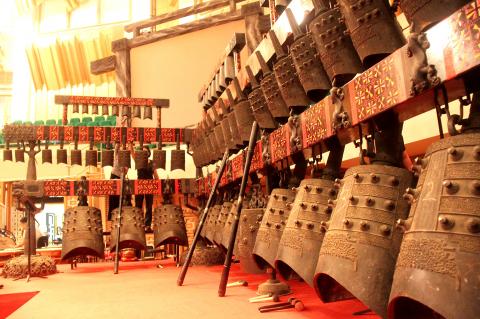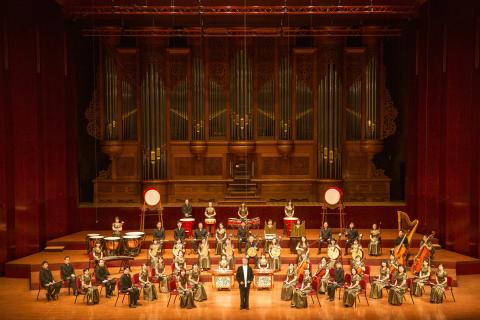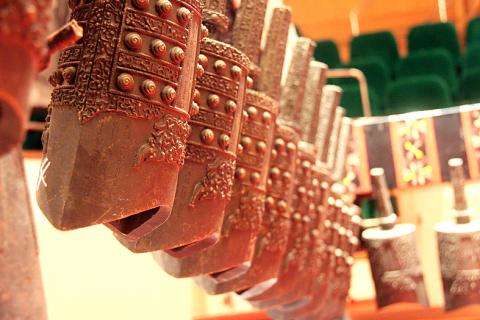The bianzhong (編鐘) is an ancient Chinese musical instrument consisting of 65 chime bells. Because it was only used for performances at the imperial court, it came to be known as the “instrument of kings” (王者之器).
The National Chinese Orchestra Taiwan (NCO, 台灣國樂團) has teamed up with the China’s Chinese Chime Bells Orchestra of Hubei (中國湖北編鐘國樂團) for When Bianzhong meets Organ (當編鐘遇上管風琴), a concert at the National Concert Hall (國家音樂廳) that brings together the melodies of the bianzhong with what Wolfgang Amadeus Mozart considered to be the king of musical instruments: the organ.
Conductor Yan Huichang (閻惠昌) who last year took over as NCO’s principal guest conductor, devised the repertoire to showcase original combinations between the two majestic instruments, and between early and modern Chinese musical instruments.

Photo courtesy of NTCH
GOING THROUGH TIME
The bianzhong used by the Hubei orchestra is a replica of a full set discovered in a state of near perfect preservation in the royal tomb of Marquis Yi of Zeng (曾侯乙), dating to the Warring States period, in present day Hubei Province. The 1978 excavation was important because it provided archeologists with a clearer understanding of ancient court musical practices.
Each bell produced two different musical notes, of a slightly different musical scale to Western music, depending on where they were struck. The twin-tone capability allows it to complete a 12-tone scale, Yan said.

Photo courtesy of NTCH
Yan said that the pitch of the replica bianzhong is slightly different because it has been tuned in a way suited to contemporary musical instruments and orchestral performances.
The bells are typically arranged on three wooden frames according to their pitches, which requires a meticulous process of assembling and dismantling.
The replica includes 65 bronze chime bells and weighs over six tons.

Photo courtesy of NTCH
“It takes 15 to 20 trained people two hours to install the bells,” Yan said.
Wang I-yu (王乙聿) will perform Majestic Demeanor (王者之聲), a new piece he wrote for pipe organ.
“On the one hand, Wang’s work delivers a robust contrast between bianzhong and organ; yet at some points, the two complement each other in harmony,” Yan said.
In addition to Wang’s work, the concert will stage five other compositions, such as German composer Robert Zollitsch’s Resounding Chimes. Zollitsch, who goes by the name Lao Luo (老鑼), visited the Hubei museum to study the timbre and performing techniques of the chime bells first hand.
“Lao Luo’s piece employs nearly all 65 chime bells, which needs 13 performers to play. The extensive use of the bells brings bianzhong music to another level,” Yan said.
When Bianzhong meets Organ is a part of the Taiwan International Festival of Arts (台灣國際藝術節), which began earlier this month.

In the March 9 edition of the Taipei Times a piece by Ninon Godefroy ran with the headine “The quiet, gentle rhythm of Taiwan.” It started with the line “Taiwan is a small, humble place. There is no Eiffel Tower, no pyramids — no singular attraction that draws the world’s attention.” I laughed out loud at that. This was out of no disrespect for the author or the piece, which made some interesting analogies and good points about how both Din Tai Fung’s and Taiwan Semiconductor Manufacturing Co’s (TSMC, 台積電) meticulous attention to detail and quality are not quite up to

April 21 to April 27 Hsieh Er’s (謝娥) political fortunes were rising fast after she got out of jail and joined the Chinese Nationalist Party (KMT) in December 1945. Not only did she hold key positions in various committees, she was elected the only woman on the Taipei City Council and headed to Nanjing in 1946 as the sole Taiwanese female representative to the National Constituent Assembly. With the support of first lady Soong May-ling (宋美齡), she started the Taipei Women’s Association and Taiwan Provincial Women’s Association, where she

Chinese Nationalist Party (KMT) Chairman Eric Chu (朱立倫) hatched a bold plan to charge forward and seize the initiative when he held a protest in front of the Taipei City Prosecutors’ Office. Though risky, because illegal, its success would help tackle at least six problems facing both himself and the KMT. What he did not see coming was Taipei Mayor Chiang Wan-an (將萬安) tripping him up out of the gate. In spite of Chu being the most consequential and successful KMT chairman since the early 2010s — arguably saving the party from financial ruin and restoring its electoral viability —

It is one of the more remarkable facts of Taiwan history that it was never occupied or claimed by any of the numerous kingdoms of southern China — Han or otherwise — that lay just across the water from it. None of their brilliant ministers ever discovered that Taiwan was a “core interest” of the state whose annexation was “inevitable.” As Paul Kua notes in an excellent monograph laying out how the Portuguese gave Taiwan the name “Formosa,” the first Europeans to express an interest in occupying Taiwan were the Spanish. Tonio Andrade in his seminal work, How Taiwan Became Chinese,